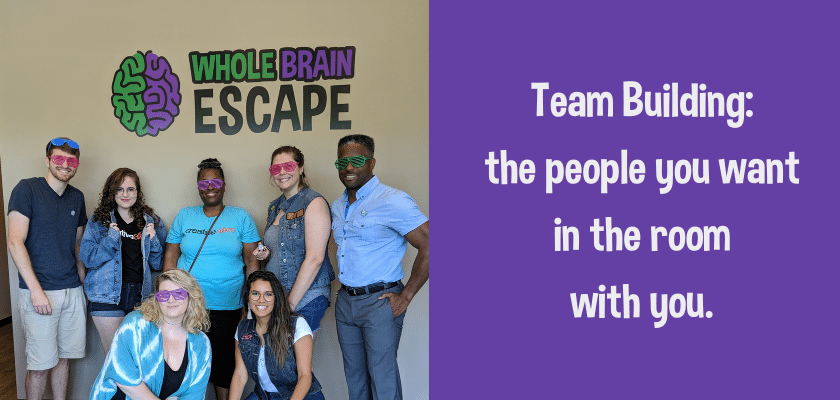It’s been said that one’s true character is best revealed during a game. Consider doing an escape room to help your team work together more effectively.
An escape room is a real-life interactive adventure game where your team works together to solve puzzles and riddles using clues, strategy, and cooperation. The goal is to complete the objectives and escape. A variety of puzzle types and a shared goal make escape rooms perfect for team-building. Players work together and rely on the skills of everyone in the group to successfully break out.
Another benefit of taking the team out of the 9-5 office environment and exposing them to a timed challenge, is that the team members let down their guard, pull together, and help each other overcome the room’s obstacles.
During this activity, different team roles may emerge based on people’s strengths. If there are a variety of strengths represented, each person is more likely to fulfill one of the key positions that are crucial during a team escape.
Scott Nicholson, a professor of Game Design and Development at Wilfrid Laurier University in Brantford, Ontario and the director of the Brantford Game Network game lab (BGNlab), has written research papers on escape rooms, meaningful gamification, and more. His blog, The Eight Roles for Escape Room Success, discusses the team positions that are useful for an escape room. What’s interesting is that some of these roles are also important on a team in general. So by doing the escape room activity, your team is also learning how effectively they work together and what each person contributes to the team. Here are five roles that are important in an escape room and on a project team.
The Project Manager
The Project Manager facilitates the flow of information and oversees all activities taking place. They have a good understanding of the inner workings and dynamic of the group, and can serve as the main point of contact for the rest of the team. Once in the room they make sure that the information is flowing between everyone on the team, so people know which puzzles have been solved and which haven’t. They can also direct people to work on particular tasks, especially when someone is unsure about what they should be doing.
The Quartermaster
With the Project Manager taking point on communication and information, the Quartermaster is focused on the resources and tools in the room. All the props, knickknacks, and objects in the room should be reviewed by the Quartermaster. This person makes connections between the objects and the puzzles that can be solved with them. Their role is most effective if people are diligent about reporting what they find to the Quartermaster. For example, this role can make a connection between an object someone found on the shelf and a picture that someone else located on the back of a book. The Quartermaster should work in tandem with the Project Manager and the Searcher (who we’ll get to next).
The Searcher
The title says it all! One person on the team usually sees the devil in the details. This is the person looking inside the books, finding hidden messages on clues, and looking inside the small box inside the big box. Being in the weeds is not always a bad thing – provided the Searcher doesn’t linger there too long. The Project Manager can help ensure that the Searcher continues to move around the room. The Quartermaster tracks what objects and clues the Searcher uncovers. On a project team, Searchers support all members of the team by providing specific and detailed information that can be applied to the project.
The Worker
With the Project Manager, Quartermaster, and Searcher all focused on finding and disseminating information, and making connections on tasks that need to be done, the Worker is the person who executes on these things. The Worker is persistent and diligent about following through on a puzzle solution. If the lock doesn’t open on the first try, the worker will go back to the puzzle and review it again. They are willing to ask for help when needed, especially when they are blocked. They work best when they focus on solving a puzzle before moving on to the next one, as this reduces the amount of confusion about which puzzles are in play. This is an important supporting role on the team and depending on the size of the challenge, you may need several Workers.
The Thinker
The Thinker is curious and thinks outside the box. They understand various approaches for solving a puzzle and work with the team to determine the best strategy. They help keep the team focused on solving problems and help people get back on track by looking at a problem with fresh eyes and offering alternative solutions. On a project team, the Thinker considers the bigger picture and future needs of the project, which helps the Project Manager and Quartermaster forecast what resources and solutions will be needed.
How do these roles map to your current team? How can your team better understand their role and the role of others on the team? What will they learn about themselves in an escape room? Will they naturally gravitate to the roles they are assigned to at work, or will they gravitate to a different role? Regardless of what roles they have on the team, they will enjoy the experience of working together to overcome the challenges presented in an escape room!
Learn more about the Whole Brain Escape Team Building experience and book your next bonding adventure today!

